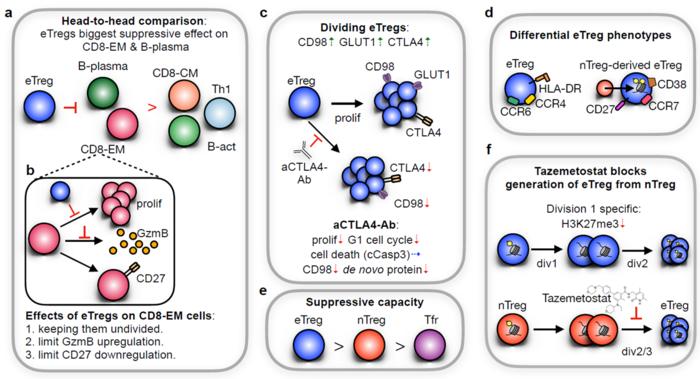
In an exciting breakthrough in immunology, researchers at Osaka University have unveiled a cutting-edge technique that alters our understanding of how regulatory T cells (Tregs) control other immune cell types. Traditionally, the intricacies of Treg interactions have remained elusive, leading to gaps in knowledge regarding their roles in health and disease. Now, with the advent of single-cell suppressive profiling of Tregs, abbreviated as scSPOT, scientists can investigate these interactions with unparalleled precision, deciphering the vital functions that Tregs perform in a complex immune environment.
Tregs are a specialized subset of T cells responsible for maintaining immune homeostasis. One of their primary jobs is to rein in the immune response, balancing the body’s need to fight off infections and malignancies while preventing autoimmunity. As the frontline defenders, T cells, particularly the CD8-EM subset, play a pivotal role in safeguarding our bodies against malignant cells and pathogens. However, the interaction dynamics between these cells and Tregs had previously been challenging to study, requiring novel methodologies to unlock their secrets.
The study published in Nature Communications highlights the potential of using scSPOT to analyze Treg behavior in real-time, observing their influences across multiple immune cell types simultaneously. This method enables researchers to discover insights previously hidden behind the complexities of cellular interactions, allowing them to observe, analyze, and quantify the suppressive effects of Tregs in the immune environment.
Jonas Nørskov Søndergaard, the first author of the study, notes that the scSPOT technique is a game-changer for the field of immunology. It offers a way to study Tregs’ interactions in a manner closely mirrored to physiological conditions found in humans, enhancing the understanding of their functional dynamics. This refined perspective could have significant implications for cancer therapy, autoimmune diseases, and infectious diseases.
In this groundbreaking research, the team discovered that Tregs exert their strongest influence over CD8-EM cells, inhibiting their proliferation and reducing the expression of Granzyme B (GzmB), a crucial protein associated with T cell cytotoxicity, while preserving the expression of CD27, a marker of T cell activation. This nuanced control underscores the delicate balance Tregs maintain in managing immune responses. As memory T cells, CD8-EM cells are essential for long-term immunity, making their modulation by Tregs a pivotal aspect of immune regulation.
Moreover, the research highlighted that Tregs serve as critical targets for cancer therapeutics such as ipilimumab and tazemetostat. These drugs, while sharing a common goal of enhancing antitumor immune responses, affect Tregs in fundamentally different ways. Understanding these interactions through the lens of scSPOT could inform new strategies to maximize therapy efficacy while minimizing potential adverse effects on the immune system.
The findings bring to light the significance of Tregs as mediators of severe viral infections, specifically by identifying unique Treg subsets in patients experiencing severe cases of COVID-19. The distinct profiles outlined by scSPOT reveal Treg types associated with heightened immunological responses, guiding clinicians towards identifying high-risk patients more effectively. This capability stands to transform clinical practices by enabling timely interventions during viral outbreaks and improving patient management strategies.
The study also raises the prospect of developing biomarkers for severe viral infections, which could help healthcare professionals ascertain potential risks in patients at an early stage. Identifying these markers would be crucial not only for public health responses but also for tailoring individualized treatment plans, offering a more personalized approach to managing infections.
As our understanding of Tregs expands due to this innovative research, the implications for therapeutic development are profound. The interplay between Tregs and other immune cells, elucidated through scSPOT, could lead to enhanced strategies for immunotherapy, especially in oncology. By unraveling the interactions between Tregs and tumor-infiltrating lymphocytes, scientists can devise therapies that improve outcomes for cancer patients, contributing to a future where immunotherapy becomes even more precise and effective.
The scSPOT method’s success also serves as a vital reminder of the significance of advancing techniques within the immunology field. By innovating and employing modern approaches, researchers can tackle long-standing questions about immune function and its implications for health and disease. This paves the way for a new era in immunological research, with potential revelations that have the power to impact therapies for cancer, infectious diseases, and beyond.
In conclusion, the incredible strides made by the Osaka University research team not only enhance our understanding of Tregs but also illuminate the path toward more effective immunotherapies. As we glean more details about the immune system’s intricacies, we will inevitably improve how we diagnose and treat diseases, leading to better health outcomes on a global scale. The implications of this work reinforce the concept that understanding our immune system is essential for developing innovative therapeutic strategies that align closely with the needs of patients.
Advancements in technology and methodology, like scSPOT, will continue to refine our approach to immunology, fostering collaboration across disciplines and bestowing our understanding with a renewed depth that transcends previous limitations.
Subject of Research: Human regulatory T cells
Article Title: Single cell suppression profiling of human regulatory T cells
News Publication Date: 3-Feb-2025
Web References: Nature Communications
References: Ørskov Søndergaard et al. (2025), Single cell suppression profiling of human regulatory T cells, Nature Communications
Image Credits: 2025 Søndergaard et al., Nature Communications
Keywords: T cells, Regulatory T cells, Immune system, Cancer therapy, Viral infections, COVID-19, Immunotherapy, Biomarkers, Single-cell analysis, Cellular interactions, Immune homeostasis, Drug development.
Tags: advancements in immunotherapyCD8-EM T cells roleimmune cell interactions researchimmune homeostasis and diseaseimmunology breakthroughs 2023Nature Communications publicationOsaka University immunology studyreal-time Treg behavior analysisregulatory T cells interactionsrevolutionary immune probing techniquesingle-cell suppressive profiling of TregsT cell dynamics in immunity





